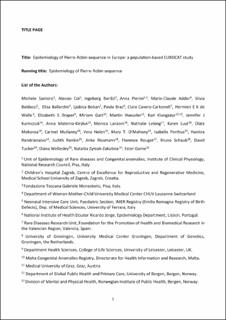Epidemiology of Pierre-Robin sequence in Europe: A population-based EUROCAT study
Santoro, Michele; Coi, Alessio; Barišić, Ingeborg; Pierini, Anna; Addor, Marie-Claude; Baldacci, Silvia; Ballardini, Elisa; Boban, Ljubica; Braz, Paula; Cavero-Carbonell, Clara; de Walle, Hermien E.K.; Draper, Elizabeth S.; Gatt, Miriam; Haeusler, Martin; Klungsøyr, Kari; Kurinczuk, Jennifer J.; Materna-Kiryluk, Anna; Lanzoni, Monica; Lelong, Nathalie; Luyt, Karen; Mokoroa, Olatz; Mullaney, Carmel; Nelen, Vera; O'Mahony, Mary T.; Perthus, Isabelle; Randrianaivo, Hanitra; Rankin, Judith; Rissmann, Anke; Rouget, Florence; Schaub, Bruno; Tucker, David; Wellesley, Diana; Zymak-Zakutnia, Nataliia; Garne, Ester
Journal article, Peer reviewed
Accepted version

View/
Date
2021Metadata
Show full item recordCollections
Abstract
Background
Pierre Robin sequence (PRS) is a rare congenital anomaly. Respiratory disorders and feeding difficulties represent the main burden.
Objective
The aim of this study was to investigate the epidemiology of PRS using a cohort of cases from EUROCAT, the European network of population-based registries of congenital anomalies.
Methods
We analysed cases of PRS born in the period 1998-2017 collected by 29 population-based congenital anomaly registries in 17 different countries. We calculated prevalence estimates, prenatal detection rate, survival up to 1 week, and proportions of associated anomalies. The effect of maternal age was tested using a Poisson regression model.
Results
Out of 11 669 155 surveyed births, a total of 1294 cases of PRS were identified. The estimate of the overall prevalence was 12.0 per 100 000 births (95% CI 9.9, 14.5). There was a total of 882 (68.2%) isolated cases, and the prevalence was 7.8 per 100 000 births (95% CI 6.7, 9.2). A total of 250 cases (19.3%) were associated with other structural congenital anomalies, 77 cases (6.0%) were associated with chromosomal anomalies and 77 (6.0%) with genetic syndromes. The prenatal detection rate in isolated cases was 12.0% (95% CI 9.8, 14.5) and increased to 16.0% (95% CI 12.7, 19.7) in the sub-period 2008-2017. The prevalence rate ratio of non-chromosomal cases with maternal age ≥35 was higher than in cases with maternal age <25 for total (PRR 1.26, 95% CI 1.05, 1.51) and isolated cases (PRR 1.33, 95% CI 1.00, 1.64). Survival of chromosomal cases (94.2%) and multiple anomaly cases (95.3%) were lower than survival of isolated cases (99.4%).
Conclusions
This epidemiological study using a large series of cases of PRS provides insights into the epidemiological profile of PRS in Europe. We observed an association with higher maternal age, but further investigations are needed to test potential risk factors for PRS.